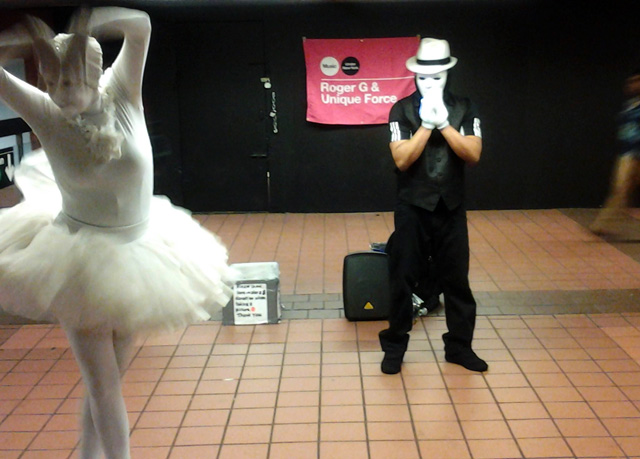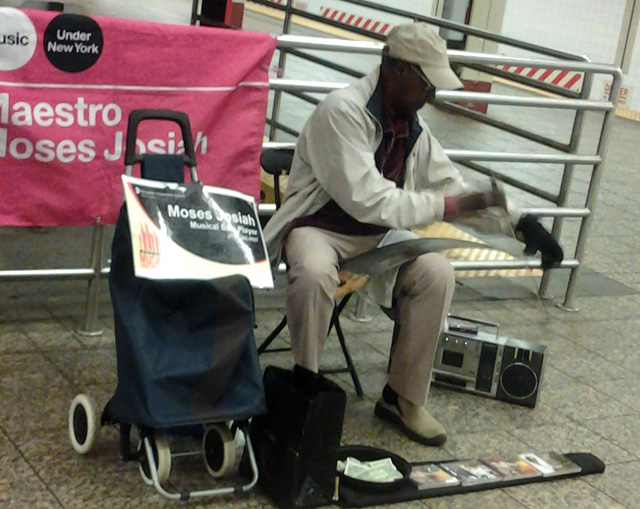Busking: The Unsung Pulse of the Subway
Text by David Szolnoki, Video by Jassiel Olivero
Tell me if this scenario is familiar. You’re on your way to a train platform at Grand Central, let’s say the uptown 4. As you go through the turnstile, you notice a man sitting on a blanket near one of the staircases, an array of instruments laid out in front of him, ranging from bongos to triangles to saxophones.
As you wait for your train, a cacophonous blast of what could be generously described as music erupts from behind you. When you turn to look, you see that the unassuming gentleman has contorted himself in such a way as to play all the instruments at once, transforming himself into a one-man orchestra, and that the case that formerly held his sax is now open with a sign asking for any donations that passersby can spare. The activity you have witnessed is known as “busking”, and it’s a fact of life on the New York City mass transit system as palpable as train delays and mumbled conductor announcements.

Roger G & Unique force
The Merriam-Webster dictionary defines a busker as “a person who entertains in a public place for donations,” which is both an accurate description of the phenomenon, and yet a grievously narrow description for the NYC incarnation of it. While it is true that most street performers (subway performers?) will have requests for monetary compensation as a part of the package, many times they do it for reasons ranging from career advancement, to cultural movements or just plain attention-grabbing.
Young rap artists try to make a name for themselves, avant-garde dance troupes seek a stage in arguably the least comfortable setting imaginable. At first, it seems senseless, or even downright malicious to cause such an uproar in a place filled with irritable, impatient folks. But if you think about the mechanics of mass-transit in general, it makes a lot of sense.
Life on the subways has become almost a social experiment of sorts over the past few decades. When you cram hundreds of people into a metal tube, and send said metal tube careening down an underground tunnel, it comes to resemble a human petri dish more than any sane mode of transportation. And to the artistically ambitious or monetarily desperate, they become something else: a captive audience.

Fun fact: sunglasses are important when performing in the medium-to-low lighting of NYC’s subterranean transportation hubs.
If anything else, you can’t fault performers for originality or vim. In my decade-plus of traveling the subway, I’ve seen roving groups of young men enter a subway car, only to break into a complex dance routine, before exiting just as unassumingly as they had entered. A man with a boombox (an anachronism in and of itself in 2013) once played his horribly atonal covers of gospel songs for the whole car to hear, only to present us with cassettes we could buy at the end. A man sitting by the 42nd Street shuttle earned some nervous glances when he pulled out a rusty saw, only to then pull out a violin bow and begin making surprisingly beautiful music by playing it like an instrument.
One time, I was followed by a man who had painted himself to resemble a nearby wall, in some bizarre Apocalypse Now-style game of stalking which, if the shuttle hadn’t come moments later, I’m convinced may have ended in my murder. Just as every performer has a schtick, every traveller has a story. Just as every performer has a schtick, every traveller has a story.
The art of busking, as it were, is so widespread that by now it’s more a subculture than a bunch of isolated dandies, with its own shared regulations and norms among its seemingly disparate members. And like any cultural movement in this day and age, there is a representative internet presence. We have busk.com, which is akin to a “how-to” guide for aspiring performance artists, and even lists on its homepage “learn how to not get arrested” as one of the skills you can learn.

fun fact
There’s The Busker Project, which is a full social media system including a Youtube channel and Facebook page, that acts as a sort of international gathering mecca for performers of all stripes and types. And of course, you can’t forget the thousands of pictures and videos that show up on media sharing websites like Youtube, Flickr and Twitter, which in a bit of irony provides street performers precisely the kind of exposure that they had been seeking in the first place.
We may sometimes really, REALLY not want to hear the word of Jesus at 6:00 in the morning, or hear why we need some dude’s mix-tape in our lives, but we accept it because street performers, be they on the streets or underground, are as much a part of the zeitgeist of the big city as the very transit system they inhabit, for better or worse. So be sure to pack some extra giving-change, because you never know what show you’ll be presented with when you walk down those stairs.

Like, for instance, an entire Beatles tribute band.
Saved under Featured Slide, Transit, Video
